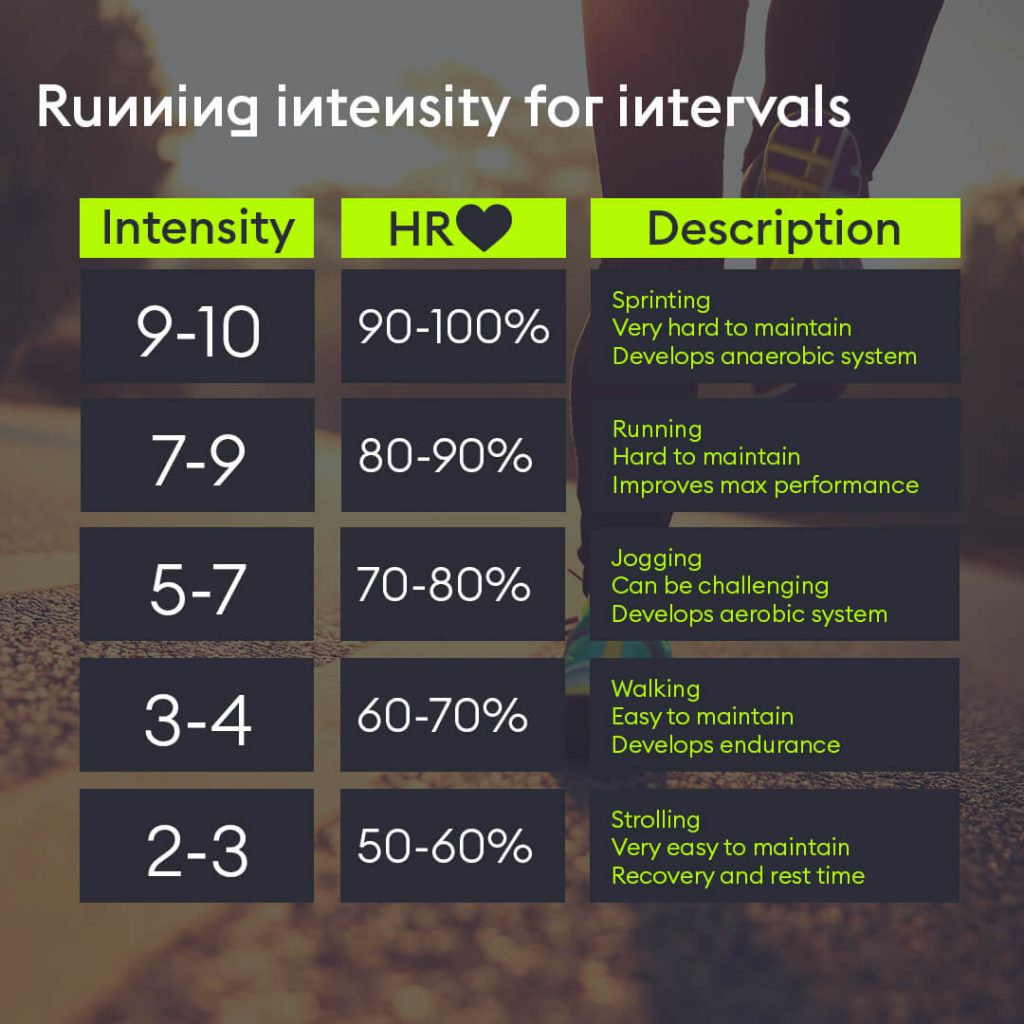Running is super accessible. We all know that. We lace up our trainers, and off we go, running at a steady pass until we complete our loop or get tired.
After a while, progress can start to plateau. Or, we fail to make progress to begin with because we find the whole thing so dull.
Intervals are not only used to encourage fitness progression, but they also offer an alternative to those who need a bit more stimulation than a long consistent jog offers.
So, here we go. What are intervals, and how should we use them for running?
Running for cardiovascular fitness
Running is an excellent form of cardiovascular exercise. It develops your aerobic fitness by conditioning your body to use and transport oxygen better.
Over time, exercise increases your heart’s size and strength, making it better able to pump oxygenated blood around the body and return deoxygenated blood back to the lungs. Your breathing efficiency will increase too, meaning you have more oxygen available for your working muscles.
The reality of all of this is a general feeling of being ‘fitter’ because you can work harder and longer in the aerobic zone.
What the intensity of your running means
Not all running is created equal. As you’ll have experienced, there’s a big difference between a jog and a sprint. The latter being a hell of a lot harder.
The intensities (altered through speed or incline) of your exercise change the heart rate you’re working at. The higher your heart rate, the more intense the exercise. At higher intensities, the body will use different energy systems to provide the fuel for movement.
That means, continually training at the same intensity and the same heart rate will condition your body in one way and will develop mainly one energy system.
Exercise intensities can be measured by the percentage of your maximum heart rate. But that’s all a bit science-y for our liking. It’s easier to think of it as a scale of 1-10. Sounds a bit basic, but this scale is a recognised and widely used one in the fitness community. Google the RPE scale if you’re feeling curious. If 1 is what it feels like to be lying in bed barely moving, and 10 is what it feels like when you couldn’t possibly do any more, you can use this scale to measure how intense exercise is.

Same speed running
When you head out for a run, you probably run continuously at the same speed until the end. (Except for maybe a sprint finish if that’s your thing).
Running like this develops your aerobic system. It’s called long slow duration. It’s one type of training system for cardiovascular exercise. On that 1-10 scale, you feel about 7 the whole time, which is a manageable intensity to maintain for the entirety of your run.
For some people, this is the perfect way to train. Challenging, consistent, doesn’t require too much thinking, and it’s enjoyable. But for others, running in this way is boring and leads to a plateau in fitness progress. This is where intervals can come into it.
Interval Training
Interval training involves structured periods of high and then low-intensity exercise, called work and rest phases.
Instead of running at that 7 the entire time, you might switch between an 8/9 and a 5/6. By working between different ends of the spectrum, interval training helps the aerobic system to develop fully. You’ll condition your body to work more effectively at higher heart rates.
The traditional work to rest ratio for interval training is 1:1. These intervals should last between 3-4 minutes.
In the work phase, choose an intensity that is a challenge for your current fitness levels. This might be somewhere between 7-9 out of 10. It also might change on each interval.
In the rest phase, don’t stop altogether. It’s more of active rest, where you bring the intensity right down to aid recovery whilst keeping moving. Somewhere between a 5-6 perhaps.
The number of times you repeat intervals depends on how long you want your overall session to be. It’s recommended to keep this under 60 minutes.
Here’s an example for a 30-minute interval run:
| Time | Phase | Intensity (/10) |
|---|---|---|
| 00:00-03:00 | Rest | 6 |
| 03:00-06:00 | Work | 8 |
| 06:00-09:00 | Rest | 6 |
| 09:00-12:00 | Work | 8.5 |
| 12:00-15:00 | Rest | 5.5 |
| 15:00-18:00 | Work | 9 |
| 18:00-21:00 | Rest | 5 |
| 21:00-24:00 | Work | 8.5 |
| 24:00-27:00 | Rest | 5 |
| 27:00-30:00 | Work | 9 |
High-Intensity Interval Training (HIIT)
Ah, HIIT. You’ve probably heard of it before. And you might associate it with fitness classes that include lots of burpees and squat jumps. It can involve that, but that’s not what it means by definition.
We’ve taken interval training and added high-intensity in front of it, which simply means your maximum intensity goes from being up to 9 to above 9. This is better suited to aerobically conditioned people ready to step it up to the next stage.
High-intensity interval training doesn’t just help develop the aerobic system but can also develop another energy system, too: the anaerobic system. This is the system that looks after your body during short, sharp, intense periods of exercise. It’s a different system because there’s no time to use oxygen for it. The harder you work, the more oxygen your body needs. At some point, your need for oxygen will surpass your supply of it. Here’s where you’re into the anaerobic zone.
Because it’s so much higher in intensity, this type of training should be used sparingly. Once per week is plenty if you’re really hitting that 10/10 for intensity.
For HIIT, the work to rest ratio is slightly different. You’ll need much more time for recovery. Around 1:4 or 1:5 is a good structure. The work periods should be between up to 1 min 30 secs maximum. The exact figures you choose will depend on how close you’re getting to that 10/10 for intensity. Proceed with caution – only the most advanced exercisers should look to hit their maximum heart rate.
The entire session shouldn’t last for longer than 30 minutes. Here’s an example of a 12-minute HIIT run:
| Time | Phase | Intensity (/10) |
|---|---|---|
| 00:00-04:00 | Rest | 5 |
| 04:00-05:00 | Work | 9 |
| 05:00-09:00 | Rest | 4 |
| 09:00-10:00 | Work | 9.5 |
| 10:00-14:00 | Rest | 4 |
| 14:00-15:00 | Work | 9.5 |
| 15:00-19:00 | Rest | 3.5 |
| 19:00-20:00 | Work | 9 |
Finding the right intensity
It can be difficult to decide out of 10 how hard you think you’re working, especially when you only have a short time to get there.
Rate of Perceived Exertion (RPE) is what fitness professionals call this 1-10 scale, but there can be other ways to measure it if you’re looking to implement it into your running.
If you have a smartwatch that tracks your heart rate, that’s one way to go. If you want to get super into it, you can figure out your maximum heart rate, and then work out your % heart rates and where you should be working for each interval.
Or you can find your average pace for your runs and label that as a 7/10 for intensity. From there, you can figure out how much faster you need to go to increase the intensity to 8 or 9.
Whatever way you choose to do it, running is a great way to develop your aerobic system and stay fit. Both consistent speed and interval training are good for you. There’s no need to do both or pick between them.
If running isn’t your thing altogether, then there are loads of other ways to look after your cardiovascular system. Walking is often enough.
Whatever works for you and your version of fitness.



